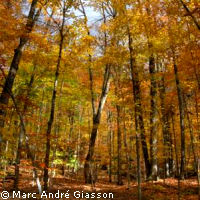Warmer autumns affecting forest carbon sink capacity
Warmer autumn temperatures are causing the carbon sink capacity of northern forests to decline, according to new findings from an international team of researchers. The loss of carbon to the atmosphere in autumn now almost entirely cancels out the extra carbon taken up by these ecosystems thanks to warmer spring temperatures. The work, which is published in the latest edition of the journal Nature, was partly funded by the EU and was carried out in the framework of the Global Carbon Project. The carbon balance of terrestrial ecosystems is particularly sensitive to temperature changes at either end of the growing season. Over the past two decades, autumn temperatures in northern latitudes have risen by 0.8°C while spring temperatures have gone up by 1.1°C. Recent studies have shown that increased temperatures in spring lead to increased carbon uptake at the start of the growing season. In this latest study, the scientists used satellite data and computer modelling to investigate the impacts of a warmer autumn on carbon uptake. They found that both photosynthesis (which removes carbon dioxide from the atmosphere) and respiration (which releases it) increase during warmer autumns. However, respiration is given a greater boost by these warmer temperatures than photosynthesis, leading to a net loss of carbon from the northern forests during warmer autumns. According to the researchers, this is due to limitations of radiation and temperature on photosynthesis in the autumn, and to soil desiccation carried over from the dry summer period. Furthermore, the extent of this autumnal loss of carbon from the system offsets around 90% of the increased carbon uptake during spring. 'If warming in autumn occurs at a faster rate than in spring, the ability of northern ecosystems to sequester carbon will diminish in the future,' warned lead author Dr Shilong Piao of the Laboratory of Climate and Environmental Sciences in Paris, France. 'The potentially rapid decline in the future ability of northern terrestrial ecosystems to remove atmospheric carbon dioxide would make stabilisation of atmospheric CO2 concentrations much harder than currently predicted,' added Philippe Ciais, a colleague of Dr Piao. The scientists note that this asymmetrical response of these northern forest ecosystems to spring and autumn warming makes it very hard to predict the future capacity of these important carbon sinks. 'Acquiring a greater understanding of responses of terrestrial ecosystems to climate trends at the edges of the growing season, including potential acclimation processes, is clearly a priority,' they write. Just over half of the carbon dioxide released into the atmosphere is absorbed by natural carbon 'sinks', with land sinks removing slightly more than ocean sinks. Recent research by the Global Carbon Project revealed that the declining efficiency of these sinks is contributing to the rise in overall levels of greenhouse gases in the atmosphere. EU support for this latest piece of research came from the ENSEMBLES and CARBOEUROPE projects, both of which are funded under the 'Sustainable development, global change and ecosystems' Thematic area of the Sixth Framework Programme (FP6).



